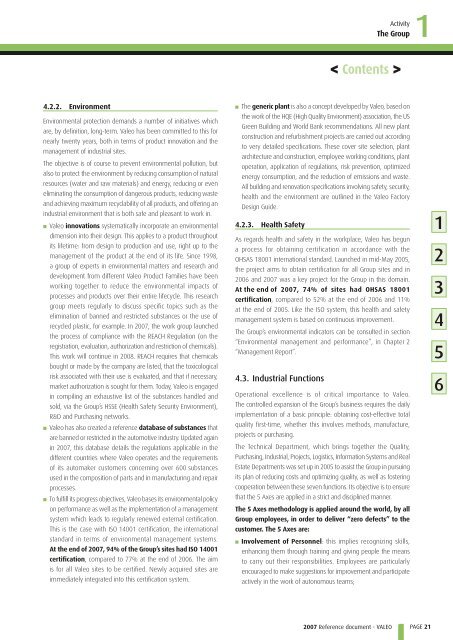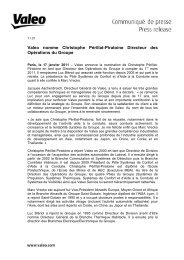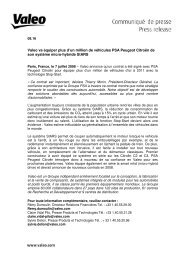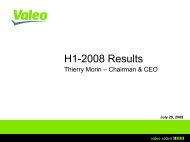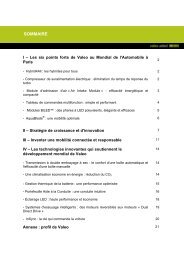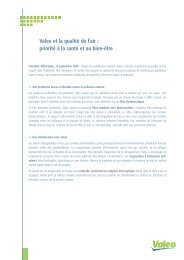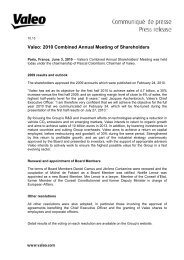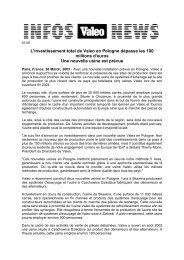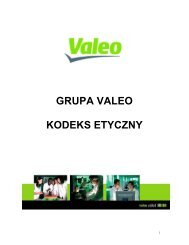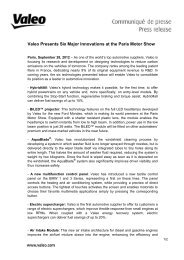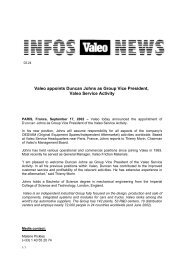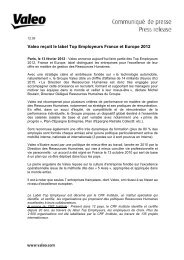2007 Reference document (PDF) - Valeo
2007 Reference document (PDF) - Valeo
2007 Reference document (PDF) - Valeo
You also want an ePaper? Increase the reach of your titles
YUMPU automatically turns print PDFs into web optimized ePapers that Google loves.
4.2.2. Environment<br />
Environmental protection demands a number of initiatives which<br />
are, by definition, long-term. <strong>Valeo</strong> has been committed to this for<br />
nearly twenty years, both in terms of product innovation and the<br />
management of industrial sites.<br />
The objective is of course to prevent environmental pollution, but<br />
also to protect the environment by reducing consumption of natural<br />
resources (water and raw materials) and energy, reducing or even<br />
eliminating the consumption of dangerous products, reducing waste<br />
and achieving maximum recyclability of all products, and offering an<br />
industrial environment that is both safe and pleasant to work in.<br />
■<br />
■<br />
■<br />
<strong>Valeo</strong> innovations systematically incorporate an environmental<br />
dimension into their design. This applies to a product throughout<br />
its lifetime: from design to production and use, right up to the<br />
management of the product at the end of its life. Since 1998,<br />
a group of experts in environmental matters and research and<br />
development from different <strong>Valeo</strong> Product Families have been<br />
working together to reduce the environmental impacts of<br />
processes and products over their entire lifecycle. This research<br />
group meets regularly to discuss specific topics such as the<br />
elimination of banned and restricted substances or the use of<br />
recycled plastic, for example. In <strong>2007</strong>, the work group launched<br />
the process of compliance with the REACH Regulation (on the<br />
registration, evaluation, authorization and restriction of chemicals).<br />
This work will continue in 2008. REACH requires that chemicals<br />
bought or made by the company are listed, that the toxicological<br />
risk associated with their use is evaluated, and that if necessary,<br />
market authorization is sought for them. Today, <strong>Valeo</strong> is engaged<br />
in compiling an exhaustive list of the substances handled and<br />
sold, via the Group’s HSSE (Health Safety Security Environment),<br />
R&D and Purchasing networks.<br />
<strong>Valeo</strong> has also created a reference database of substances that<br />
are banned or restricted in the automotive industry. Updated again<br />
in <strong>2007</strong>, this database details the regulations applicable in the<br />
different countries where <strong>Valeo</strong> operates and the requirements<br />
of its automaker customers concerning over 600 substances<br />
used in the composition of parts and in manufacturing and repair<br />
processes.<br />
To fulfill its progress objectives, <strong>Valeo</strong> bases its environmental policy<br />
on performance as well as the implementation of a management<br />
system which leads to regularly renewed external certification.<br />
This is the case with ISO 14001 certification, the international<br />
standard in terms of environmental management systems.<br />
At the end of <strong>2007</strong>, 94% of the Group’s sites had ISO 14001<br />
certification, compared to 77% at the end of 2006. The aim<br />
is for all <strong>Valeo</strong> sites to be certified. Newly acquired sites are<br />
immediately integrated into this certification system.<br />
■<br />
<strong>2007</strong> <strong>Reference</strong> <strong>document</strong> - VALEO<br />
Activity<br />
The Group<br />
The g eneric plant is also a concept developed by <strong>Valeo</strong>, based on<br />
the work of the HQE (High Quality Environment) association, the US<br />
Green Building and World Bank recommendations. All new plant<br />
construction and refurbishment projects are carried out according<br />
to very detailed specifications. These cover site selection, plant<br />
architecture and construction, employee working conditions, plant<br />
operation, application of regulations, risk prevention, optimized<br />
energy consumption, and the reduction of emissions and waste.<br />
All building and renovation specifications involving safety, security,<br />
health and the environment are outlined in the <strong>Valeo</strong> Factory<br />
Design Guide.<br />
4.2.3. Health Safety<br />
As regards health and safety in the workplace, <strong>Valeo</strong> has begun<br />
a process for obtaining certification in accordance with the<br />
OHSAS 18001 international standard. Launched in mid-May 2005,<br />
the project aims to obtain certification for all Group sites and in<br />
2006 and <strong>2007</strong> was a key project for the Group in this domain.<br />
At the end of <strong>2007</strong>, 74% of sites had OHSAS 18001<br />
certification, compared to 52% at the end of 2006 and 11%<br />
at the end of 2005. Like the ISO system, this health and safety<br />
management system is based on continuous improvement.<br />
The Group’s environmental indicators can be consulted in section<br />
“Environmental management and performance”, in Chapter 2<br />
“Management Report”.<br />
4.3. Industrial Functions<br />
Operational excellence is of critical importance to <strong>Valeo</strong>.<br />
The controlled expansion of the Group’s business requires the daily<br />
implementation of a basic principle: obtaining cost-effective total<br />
quality first-time, whether this involves methods, manufacture,<br />
projects or purchasing.<br />
The Technical Department, which brings together the Quality,<br />
Purchasing, Industrial, Projects, Logistics, Information Systems and Real<br />
Estate Departments was set up in 2005 to assist the Group in pursuing<br />
its plan of reducing costs and optimizing quality, as well as fostering<br />
cooperation between these seven functions. Its objective is to ensure<br />
that the 5 Axes are applied in a strict and disciplined manner.<br />
The 5 Axes methodology is applied around the world, by all<br />
Group employees, in order to deliver “zero defects” to the<br />
customer. The 5 Axes are:<br />
■<br />
< Contents ><br />
Involvement of Personnel: this implies recognizing skills,<br />
enhancing them through training and giving people the means<br />
to carry out their responsibilities. Employees are particularly<br />
encouraged to make suggestions for improvement and participate<br />
actively in the work of autonomous teams;<br />
1<br />
PAGE 21<br />
1<br />
2<br />
3<br />
4<br />
5<br />
6


